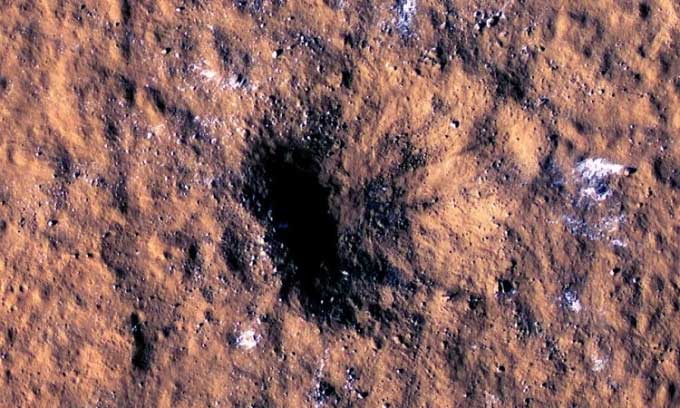Data from the InSight lander and the Mars Reconnaissance Orbiter has led NASA researchers to discover a 150-meter-wide impact crater created by a meteorite collision.
The InSight mission landed on Mars in November 2018 to observe the planet’s internal structure, map its soil layers, and identify fault lines. On December 24, 2021, the lander made a significant discovery when it recorded seismic waves from a large meteorite impact. Images captured from orbit made this discovery even more remarkable, as scientists found a new, extremely large crater.

Large boulders scattered around the impact crater. (Image: NASA).
“This is the largest crater we have ever seen,” said Ingrid Daubar, a planetary scientist at Brown University, during a press conference on October 27. “We believe that craters of this size may form on Mars every few decades. Therefore, it is exciting to witness this event, and we are fortunate that it occurred while the InSight lander was recording seismic data.”
In September, scientists from the InSight mission reported the detection of four meteorite impacts, each creating a new crater, in 2020 and early 2021. However, all of these were small impacts, with none producing earthquakes stronger than magnitude 2. The InSight team did not expect to detect signals from a larger impact, making the data received on December 24 a major surprise. The observations revealed an impact of magnitude 4, creating a crater over 130 meters wide.
While the InSight team investigates the origin of the impact, the Mars Reconnaissance Orbiter (MRO) also discovered a large, fresh impact crater, according to Liliya Posiolova, the lead scientist for the MRO’s science operations team in California. Posiolova and her colleagues first spotted the new crater in data collected by the MRO’s Context Camera.
According to Daubar, the crater spans 150 meters, equivalent to two city blocks, and is ten times the size of a typical crater on Mars. Based on the size of the crater, scientists estimate that the meteoroid that struck the Red Planet was approximately 5 to 12 meters wide. The meteoroid penetrated deep into Mars’s surface, ejecting large rocks and water ice the size of pebbles. As the impact likely destroyed the meteoroid entirely, the research team is confident that the ice ejected came from beneath the planet’s surface. The crater created by the meteorite is located about 3,500 kilometers from the InSight lander.
Researchers described the findings in two papers published on August 27 in the journal Science. This may be the final discovery from InSight to be published before the mission concludes. The lander has very little energy left due to dust accumulation on its solar panels. Its seismometer currently observes for only 8 hours over 4 Martian days. The InSight team predicts that the mission will conclude within the next few months.

















































